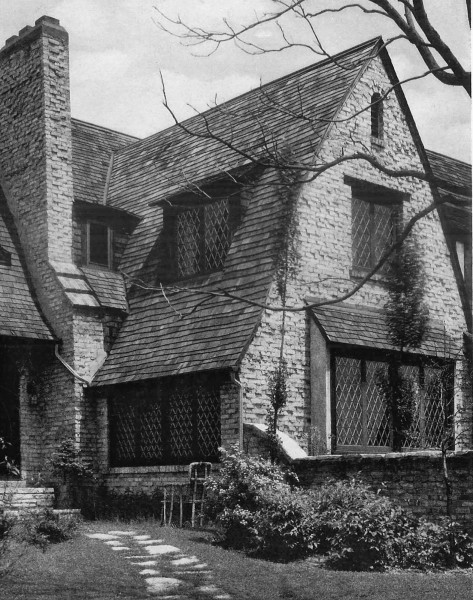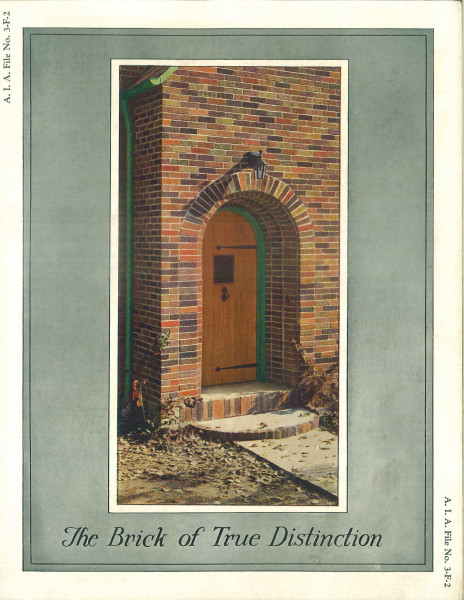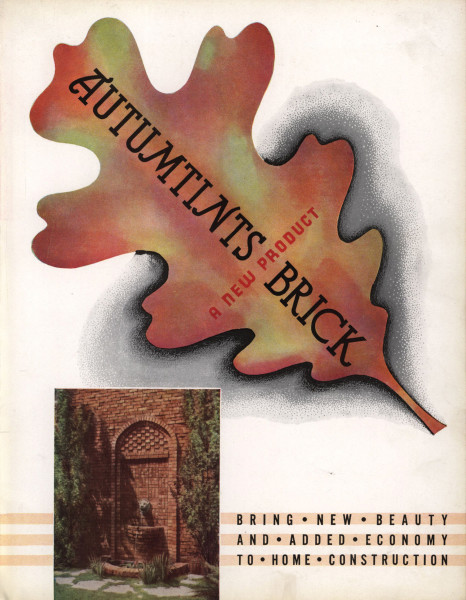Colorful, textural brick façades sprouted like wildflowers in the Thirties, Forties, and Fifties. The sales pitches were certainly clever. I suspect that these examples illustrate a change from texture to tone during the years between the wars—and period examples are worth appreciation and preservation.
Around 1930, as the larger world awoke to the exigencies of global economic collapse, the brick industry seems to have clung sleepily to the textural theatrics that had served it so well in the previous two decades. When the fashion for English, Norman, and Tudor Revival houses took hold after 1900, texture was the way to create ersatz iterations of late-medieval masonry. (Many houses were, however, built with veneer brick over terra-cotta block or stud-framed walls. The emphasis was all surface.)

Skintled brick in a house at Winnetka, Illinois, “as developed by Chicago architects,” published in a brick-association manual.
The Common Brick Manufacturers’ Assn. of America
Texture came from a party mix of materials: conventional brick walls peppered with irregularly shaped stones, bricks intriguingly abraded or shaped. Clinker bricks, those legendary rejects of the kiln, beloved by Greene & Greene, seem to ooze from the wall like overfilled muffins. Most intriguing was skintled brick, a texture conceit that turned tradi-tional bricklaying on its head.
Skintling was not a single method but a repertoire of as many as seven related effects. Bricks were set at different angles so that, instead of following a regular wall plane, they project from or recess into it. Cooked up in the 1920s by Chicago architects looking to put a novel spin on common brick (that mundane standby of unit masonry), skintling often featured squeezed-out mortar allowed to harden in place. Though skintling zigzagged into the Depression years in more reserved versions, the cunning unpredictability of the results took a hit as homebuilders grew conservative and the taste for texture receded.

Finzer’s Forestblend: colorful bricks of distinction, with the Forestblend Oriental line meant “for small buildings.”
Courtesy Gordon Bock archive
The Use of Color
As early as 1929, some prescient brick manufacturers already were pushing color over clever masonry. For example, the Illinois Brick Company promoted their AutumTints Brick line as “Striking beauty at Low Cost.” It featured a naturalistic palette “similar to . . . a forest after the first touch of frost,” and at a price “very little more than common brick.” The Finzer Brothers Brick Company met them toe-to-toe with their Forestblend products. Although the palette was a “blending of reds, browns, blues, tangerines, greens, and polychromes representing the shades and tints of the autumn forest,” Finzer goosed the effects and saturation to “daring contrasts” in their Oriental and Range 456 lines, these deemed “suitable only for smaller surfaces.”

AutumTints Brick, from the Illinois Brick Company; bricks shown in Buff and Colonial tones.
APT Building Technology Heritage Library/Archive.org
By the 1940s, house styles as well as aesthetics were going in new directions. Period writing suggested that a house with “straight architectural lines, with all slopes eliminated, immediately stamp it as strictly modern.” No surprise that, where there’s little other surface treatment to catch the eye, “modern homes demand color.”
Indeed, if one brick color is good, two may be better. “Combinations of colors are often used,” noted the Brick Institute in 1940, citing “the strictly modern type of architecture, which is rapidly growing in popularity.” This might suggest a two-tone treatment, where “horizontal panels of protruding brick” are highlighted with a darker shade, or even two colors on the same brick in the form of iron spotting. Following this logic, some schemes mixed bricks of different colors.
Where do you go from there? Back to texture—with color—all in the same wall.







